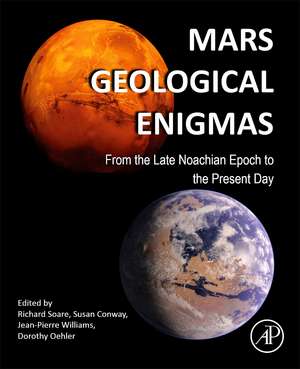Mars Geological Enigmas: From the Late Noachian Epoch to the Present Day
Editat de Richard Soare, Susan Conway, Jean-Pierre Williams, Dorothy Oehleren Limba Engleză Paperback – 27 mai 2021
- Offers a transchronological view of the geological history of Mars, addressing thematic questions from a broad temporal perspective
- Discusses outstanding questions on Mars from diverging perspectives
- Includes key questions and answers, as well as a look ahead to which puzzles remain to be solved
Preț: 696.44 lei
Preț vechi: 905.90 lei
-23% Nou
Puncte Express: 1045
Preț estimativ în valută:
133.28€ • 138.63$ • 110.03£
133.28€ • 138.63$ • 110.03£
Carte tipărită la comandă
Livrare economică 07-21 aprilie
Preluare comenzi: 021 569.72.76
Specificații
ISBN-13: 9780128202456
ISBN-10: 0128202459
Pagini: 554
Ilustrații: Approx. 150 illustrations (150 in full color)
Dimensiuni: 191 x 235 x 32 mm
Greutate: 0.94 kg
Editura: ELSEVIER SCIENCE
ISBN-10: 0128202459
Pagini: 554
Ilustrații: Approx. 150 illustrations (150 in full color)
Dimensiuni: 191 x 235 x 32 mm
Greutate: 0.94 kg
Editura: ELSEVIER SCIENCE
Public țintă
Advanced undergraduate, graduates, post docs, researchers, and faculty members in planetary scienceCuprins
1. Current enigmas identified by the Curiosity rover at the Gale crater
Node I
What sourced the enormous flows and volumes that formed the outflow channels and highland-margin contacts of ancient Mars?
2. The fluvial interpretation of outflow channels on Mars: landforms, processes and paleoenvironmental implications
3. Was there an early Mars ocean?
4. Dry megafloods on Mars: formation of the outflow channels by voluminous effusions of low viscosity lava
Node II
Can impact craters be used to derive reliable surface ages on Mars?
5. Challenges in crater chronology arising from the Jezero impact crater
6. The role of secondary craters on Martian crater chronology
Node III
The perplexing story of methane on Mars
7. Methane on Mars: subsurface sourcing and conflicting atmospheric measurements
8. A review of the meteor shower hypothesis for methane on Mars
Node IV
Does water flow on Martian slopes?
9. The possible role of water in recent surface-processes on Mars
10. Dry formation of recent Martian slope-features
Node V
Earth analogues for Mars - a plethora of choice!
11. The McMurdo Dry Valleys of Antarctica: a geological, environmental and ecological analog to the Martian surfac
12. The Atacama Desert: a window into late Mars surface habitability
13. Ancient life in diverse habitats from the Pilbara Craton and Mount Bruce Supergroup, western Australia: analogues for early Mars?
Node VI
The freeze-thaw cycling of water at/near the Martian surface: present, past and possible?
14. Pingo-like mounds and possible periglaciation/glaciation at/adjacent to the Moreux impact crater, Mars
15. Thermokarst-like depressions on Mars: age constraints on ice degradation in Utopia Planitia
Node VII
Hemispheres together: towards understanding the Mars dichotomy
16. Forging the Mars crustal-dichotomy: the giant impact hypothesis
17. Endogenic origin of the Martian hemispheric dichotomy?
James Roberts
Node I
What sourced the enormous flows and volumes that formed the outflow channels and highland-margin contacts of ancient Mars?
2. The fluvial interpretation of outflow channels on Mars: landforms, processes and paleoenvironmental implications
3. Was there an early Mars ocean?
4. Dry megafloods on Mars: formation of the outflow channels by voluminous effusions of low viscosity lava
Node II
Can impact craters be used to derive reliable surface ages on Mars?
5. Challenges in crater chronology arising from the Jezero impact crater
6. The role of secondary craters on Martian crater chronology
Node III
The perplexing story of methane on Mars
7. Methane on Mars: subsurface sourcing and conflicting atmospheric measurements
8. A review of the meteor shower hypothesis for methane on Mars
Node IV
Does water flow on Martian slopes?
9. The possible role of water in recent surface-processes on Mars
10. Dry formation of recent Martian slope-features
Node V
Earth analogues for Mars - a plethora of choice!
11. The McMurdo Dry Valleys of Antarctica: a geological, environmental and ecological analog to the Martian surfac
12. The Atacama Desert: a window into late Mars surface habitability
13. Ancient life in diverse habitats from the Pilbara Craton and Mount Bruce Supergroup, western Australia: analogues for early Mars?
Node VI
The freeze-thaw cycling of water at/near the Martian surface: present, past and possible?
14. Pingo-like mounds and possible periglaciation/glaciation at/adjacent to the Moreux impact crater, Mars
15. Thermokarst-like depressions on Mars: age constraints on ice degradation in Utopia Planitia
Node VII
Hemispheres together: towards understanding the Mars dichotomy
16. Forging the Mars crustal-dichotomy: the giant impact hypothesis
17. Endogenic origin of the Martian hemispheric dichotomy?
James Roberts
Recenzii
"Mars Geological Enigmas: From the Late Noachian Epoch to the Present Day presents outstanding questions on the geology of Mars and divergent viewpoints based on varying interpretations and analyses. The result is a robust and comprehensive discussion that provides opportunities for planetary scientists to develop their own opinions and ways forward. Each theme opens with an introduction that includes background on the topic and lays out questions to be addressed. Alternate perspectives are covered for each topic, including methods, observations, analyses, and in-depth discussion of the conclusions. Chapters within each theme reference each other to facilitate comparison and deeper understanding of divergent opinions. This title is suitable for advanced undergraduate students, graduate students, postdocs, researchers, and faculty members in planetary science." --Lunar and Planetary Information Bulletin
